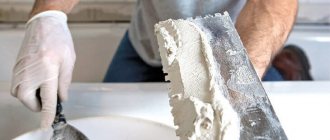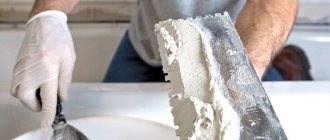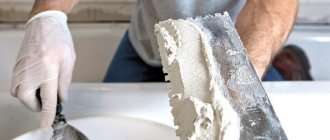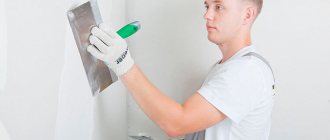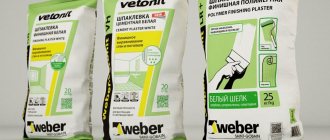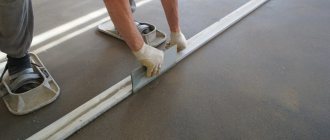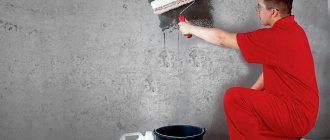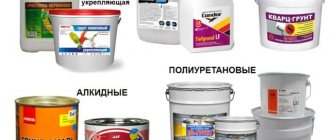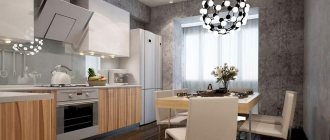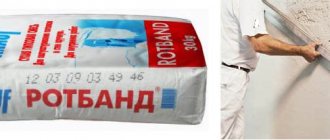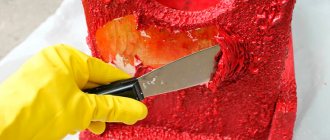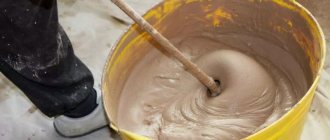The choice of plaster is the “cup” that any owner of a property such as an apartment or office will have to drink. What should you decide on in case of repair? Should I choose the cheapest plaster, should I listen to my neighbor’s opinion? Should I ask questions on the forum or trust a consultant from a construction market? Or maybe you should study this or that top plasters, but which one if all the ratings are so different?
How is cement mortar prepared?
Many people mistakenly believe that components are added to water. This method does not allow you to stir the mixture evenly. Lumps form in the solution and sand “sticks” to them.
Proper mixing requires the following procedure:
- The sand is poured in first. It must be sifted first. It is allowed to use a mesh with large cells. The main thing is to remove shells, organic particles, clay pieces, and pebbles. They cling to walls, leaving furrows behind.
- The cement is poured second. Both components are dry mixed with each other. This imposes certain requirements on the sand, which must be dry, which allows for a thorough connection of the bulk components.
- Water is poured into the dry component of the mortar for plastering walls. You cannot pour all the liquid at once. First pour out 2/3 of it. Mix everything thoroughly. The remaining liquid is poured out when it becomes unbearably difficult to mix the components.
If you follow this sequence of actions, you will get a homogeneous mixture without any lumps. It will fit perfectly on the walls and not leave any grooves.
Formulation options
Plaster varies in composition and characteristics. Next, we will analyze in more detail individual construction plaster mixtures and the conditions for their use.
Putty based
To mix the bulk you will need ordinary putty (6 kg), water (2 l) and PVA glue (0.2 l). Dry powdered putty is placed in a container, water is gradually poured in, and stirred. Then add PVA glue and mix again. In the absence of such glue, it can be replaced with drywall grout (the proportions remain the same 1: 1).
With primer
As the main material, as in the previous version, putty is used in a ratio of 3:1.
Compound:
- Putty – 9 kilograms.
- Primer – 3 liters.
- Grout – 200 grams.
- Color – added depending on the required saturation.
Preparation is carried out in the same way. The only difference is that instead of water, the mixture must be diluted with a primer. This type of plaster is used for decorative surface decoration. Therefore, the primer is used in an exceptional white color to prevent loss of quality of the selected shade.
Cement
Used as a basis for further finishing of the wall surface. There are three types of cement plaster:
- Cement-sand. Consists of cement, sand, water. Perfect for protecting walls in rooms with high humidity. It can also be used for cladding facades or interior decoration.
- Cement-lime. The difference lies in replacing water with milk of lime.
- Cement-clay. Used for finishing interior walls of rooms with moderate humidity.
The ratio of components in cement plaster
To prepare different types, compositions differing from each other in the ratio of components are used. So, to spray the surface of the walls, a ratio of 1:4 is required, the surface is primed with a solution in a ratio of 1:3, and the finishing coating is done with a steep solution - 1:2. First, mix the dry ingredients, then add water or milk of lime. The result should be a mixture with the consistency of sour cream.
Clay
Clay plaster is divided into several types:
- Clay-sand. Mainly used for finishing wooden buildings.
- Clay with the addition of sawdust, wool, felt and other materials.
- Clay-sand with the addition of fibers. It is distinguished by its ability to retain heat indoors.
The main components of clay plaster are sand, clay and water. Based on the type of work, compositions with different ratios of components are made. So, to prepare a mixture for outdoor use, you need to mix the components in a ratio of 0.2:3:1.
Clay mortar
With lime
There are three types of plaster using lime:
- Lime-gypsum mortar. Used for finishing decorative coating. Gypsum affects the setting speed of the solution. The ratio of components is 1:4, where the smaller number is dry gypsum powder.
- Lime-clay. To create plaster you will need: clay - 1 kilogram; lime dough – 0.5 kilograms; sand – 3-6 kilograms.
- Lime-cement mortar. Created in a ratio of 1:1:5. The composition is represented by a lime mixture, cement and construction sand.
Plaster
Preparation of gypsum plaster requires the presence of dry gypsum.
Compound:
- Gypsum powder – 6 kg.
- Water – 2 liters.
- PVA glue – 200 grams.
Advice! If you plan to carry out rough plastering of the walls, then add sawdust to the composition. The suggested ratio requires 1 kilogram. Larch sawdust is not suitable for use.
Venetian
This decorative plaster is prepared from ordinary fine-grained putty. Quartz, marble, malachite chips, slaked lime and color of the desired shade are added to it. The color concentration is selected individually, however, its abundance will lead to a deterioration in the quality of the solution. The total amount of lime for the entire composition varies between 50-60%. This takes 3 hours, while plaster takes 1 hour. To add gloss, after the coating has dried, it is treated with special wax.
Versailles
This finishing mixture for interior work is created on the basis of two types of putties: starting and finishing in a 1: 1 ratio. They are mixed and the desired color is added. An essential component that provides Versailles plaster with a special effect is silver. It is used after the coating has completely dried. Add to water-soluble varnish (dilute by half) and spray only the protruding parts of the relief.
Important nuances
Never pour all the liquid into dry ingredients at once. If you completely pour water into cement and sand, the mass will turn out to be too liquid, which will sharply reduce the quality of the mix. To prevent such a mistake, first use a small part, and then add the rest. It is recommended to sift sand using a mesh with different cell sizes. Bulk material for mixing the mortar used for primer layers of plaster is sifted through cells measuring 2-3 mm, and for covering layers - 1 mm.
Rating of the best gypsum plasters for interior work in 2021
| Place | Name | Price | Rating |
| The best gypsum plasters for interior work by price/quality for 2022 | |||
| 1 | KNAUF Rotband | Find out the price | 9.9 / 10 |
| 2 | Prospectors Gypsum | Find out the price | 9.8 / 10 |
| 3 | Volma Layer | Find out the price | 9.7 / 10 |
| The best machine-applied gypsum plasters for interior work | |||
| 1 | Weber Vetonit Profi Gypses | Find out the price | 9.9 / 10 |
| 2 | KNAUF MP-75 | Find out the price | 9.8 / 10 |
| 3 | Unis Teplon | Find out the price | 9.6 / 10 |
| The best leveling gypsum plasters for interior work | |||
| 1 | Volma Gips-Active | Find out the price | 9.9 / 10 |
| 2 | Rusean Termoplast | Find out the price | 9.7 / 10 |
| 3 | Unis Teplon moisture resistant | Find out the price | 9.6 / 10 |
| The best gypsum plasters for interior plasterboard work | |||
| 1 | Weber Aqua profi gyps | Find out the price | 9.9 / 10 |
| 2 | Founding gypsum PG25 W | Find out the price | 9.7 / 10 |
| 3 | Volma Plast | Find out the price | 9.6 / 10 |
| The best inexpensive gypsum plasters for interior work | |||
| 1 | Rusean Plaster | Find out the price | 9.9 / 10 |
| 2 | KNAUF Goldband | Find out the price | 9.8 / 10 |
| 3 | Volma Canvas | Find out the price | 9.5 / 10 |
What brand of cement should I choose for the mortar?
It is determined by the degree of compression of both frozen and completely dried mortar for plastering walls. The composition dries completely within 28 days. The ratio of binder and fillers, which can be perlite, fine slag, sawdust, polystyrene granules, etc. An incorrectly selected brand of cement provokes destruction of the plaster. It begins to peel, crack, and crumble due to shrinkage. This kind of plaster cannot be left. It will have to be updated. This will entail additional expenses.
Manufacturers
The modern construction market offers a huge range of plaster mixtures from various manufacturers. Thanks to this, you can solve most complex problems associated with repairs and interior design.
- Among the leaders who have established themselves well in the market are the international group of companies Knauf and Kreisel. The products of these German manufacturers have been popular for many years, thanks to the high quality standards that are strictly observed when producing building materials. The Knauf product range includes gypsum plaster compositions for interior finishing work, as well as cement mixtures used for finishing inside buildings. Kreisel offers professional plaster solutions for both manual and machine application. German products are also represented on the domestic market.
- High-quality Russian-made plaster “Starateli” is used for repairing any objects on a par with foreign manufacturers. The company offers a whole series of plaster mixtures for various purposes, including the decorative composition “Bark Beetle”, as well as gypsum and cement mortars.
- The line of plaster mixtures from many manufacturers includes decorative plaster “Wave”, which forms a moisture-resistant coating reminiscent of light ripples on the water. This textured mixture is ideal for rooms with high levels of humidity, such as kitchens or bathrooms.
- produces similar finishing coatings that allow you to create a texture to suit every taste, from simulating the blow of a light breeze on the surface of the sea to a raging stormy sea.
- Henkel Bautechnik produces Ceresit building materials, which are the undisputed leaders in the segment of products for renovation work. Repair and decoration of premises is a priority area for the company. That is why Ceresit plaster mixtures are distinguished by their excellent quality and wide variety of types. Ceresit ST 35 plaster is used for finishing facades and interior work.
The coating made with this composition is distinguished by texture and attractiveness; Ceresit ST 137 decorates the surface of the walls, creating a texture reminiscent of small pebbles.
Criterias of choice
There is no universal brand for mixing plaster. The choice is determined by what kind of work is planned to be performed. Plaster can be light, external, waterproof, internal, heat-insulating. The solution is used for spraying, priming, and covering. The main criterion is the composition of the base.
Reviews
Among modern gypsum plaster mixtures for working with surfaces of concrete, brick and plaster, Knauf Rotband composition stands out. Reviews of the product emphasize its main advantages - plasticity, excellent adhesion and environmental friendliness.
For interior finishing of surfaces for further tiling or wallpapering, Volma-Sloy plaster has proven itself well. Its disadvantages include rapid hardening, so the mixture must be diluted in small quantities.
In the ranking of companies that produce high-quality products for plastering work, the Knauf company takes the leading place. Popular Russian manufacturers are considered to be Yunis, Osnovit and Volma.
Based on the ratio of cost and quality, according to most buyers, Starateli gypsum mixture is one of the best materials for plastering surfaces. It is important that it has a small consumption per m2, and after the solution hardens it does not shrink and remains level.
Sources
- https://fasad-exp.ru/vidy-materialov-dlya-otdelki-fasadov/shtukaturka/kak-sdelat-rastvor-dlya-shtukaturki.html
- https://dekoriko.ru/shtukaturka/sostav-rastvora/
- https://gipsohouse.ru/walls/shtukaturka/17572-sostav-shtukaturnyx-smesej-ix-naznachenie-i-pravila-ispolzovaniya.html
- https://DekorShtukaturka.ru/oshtukaturivanie/rastvor-dlya-shtukaturki
- https://odnushka.ru/steny/shtukaturka/smes
- https://stroy-podskazka.ru/shtukaturka/stroitelnye-smesi/
- https://PoShtukaturke.ru/steny-vnutri/shtukaturka-vyravnivanie/cementnyj-rastvor-dlya-shtukaturki.html
- https://stroy-podskazka.ru/shtukaturka/rastvor/
Features of some brands of cement
Characteristics of various grades of cement:
- M50 . Lightweight. This brand is suitable exclusively for grouting. It is characterized by low strength and minimal shrinkage. This cement is perfect for finishing plaster.
- M100 . It has a dense composition. This brand is suitable for finishing indoor walls. It is distinguished by the presence of lime in the mixture. It is used not only for plastering, but also for leveling the surface of walls.
- M150 . It is a universal composition for plastering and masonry compositions, arranging screeds, and carrying out repairs. Reasonable cost and higher strength allow you to save on preparing the solution.
- M200 . It is produced for a specific purpose, including for plastering walls. The main feature is increased strength.
- M300 . Not suitable for plastering wall surfaces. The brand is most often used as a component of masonry mortars.
- Grades M400 and M500 have a high price, but have increased strength, so they are often used in the preparation of plaster.
Necessary tools and materials for plastering work
The quality of finishing directly depends on the tools used. Work equipment:
- Trowel (trowel).
- The rule is at least 1.5 meters long.
- Spatula - preferably 2 (narrow, wide).
- Half-grater.
- Level
- Plumb.
Finishing work is carried out both manually and using construction equipment. If it is necessary to lay a thick layer, beacon profiles are set and a construction mesh is attached. Metal corners are also used to create smooth outer corners. If there are shallow cracks, they are covered with a painting mesh with a thin layer of plaster.
Purchasing a concrete mixer is considered rational when building a private house. Since the volume is large, it is extremely difficult to manually mix the solution each time. In the case of renovation work, everything depends on the rental price.
Tools for plastering walls
Manually mixing a solution of sand, cement and water is difficult and time consuming - it is much faster to use a construction mixer. However, such equipment is expensive, and therefore it is optimal to buy a special attachment for a drill.
How to correctly determine the brand of cement for plastering wall surfaces?
Focusing solely on the purpose and properties of the brand is not the most correct approach. The choice actually depends on many factors. Experienced craftsmen test the finished cube of completely set mortar on a special stand. Craftsmen prepare plaster solutions taking into account the brand of cement.
For the M400 brand they take four buckets of sand, and for the M500 - five. Compliance with this simple rule allows you to create high-quality plaster mortar. Increasing or decreasing the amount of bulk components allows you to change the density and strength of the plaster.
Adviсe
Although it is not recommended to influence the drying time of the plaster on its own, if you ensure good air exchange in the room, the likelihood of defects occurring is reduced.
Before plastering the brick, it is better to moisten the surface, since this material has good moisture absorption. Before finishing work, it is necessary to completely clean the surface of any contaminants so that the solution exhibits better adhesion. Do not forget about preparing for plastering the facade - if there are reinforced concrete beams, they are covered with clay baked in a kiln.
It is not advisable to use gypsum plaster for exterior finishing, since it becomes deformed when exposed to rain or snow. To obtain a perfectly even coating, beacons can be installed on the surface. To do this, you first need to check the verticality of the wall, and then drive the dowels in the right places and stretch the fishing line along them. To avoid a break, it is necessary to tighten the fishing line between the outer beacons.
To correct uneven corners, apply an additional layer of plaster. If the unevenness is too large, then first completely knock down the layer of plaster and reapply it.
It is best to carry out plastering in spring or autumn, when there is no hot sun or severe frost. You can cover surfaces from the sun with a special protective canopy.
A thick layer of mortar may crack, but if it is necessary, then it is necessary to stretch a metal reinforcing mesh before applying it. It is advisable to carry out all installation work before plastering, so as not to damage the coating or pipes (wires). Communication elements are placed in special recesses in the wall and covered with plaster. Heating pipes should not be left close to the plaster, as when heated they expand and the coating is destroyed; rust spots may also appear due to the ability of gypsum to absorb moisture.
The surfaces must be completely free of dust, otherwise the plaster will not adhere properly to them.
Technical parameters of finishing mortar for walls
The plaster mixture has several important characteristics:
- Strength for mortars when 3 buckets of sand are placed on M500 cement.
- Thermal conductivity of heavy compositions and dense plaster with a decrease in the proportion of the bulk component.
- Water resistance for dense solutions. The lungs can be modified by adding substances that increase the mixture's resistance to water. The most commonly used materials are ceresite, liquid glass, and polymer resins.
- Frost resistance, characteristic of light varieties of plasters, when M500 grade cement is taken to prepare the mortar and mixed with 6 buckets of sand or less. These mixtures are used for finishing walls only indoors. External plastering of walls is not carried out in this way.
The technical properties of the mixtures are directly determined by the density of the solution. Lightweight ones are ideal for plastering walls indoors, and heavy ones, which are highly resistant to frost and moisture, are ideal for plastering walls outside.
Which plaster is better: dry or wet?
To understand which plaster to choose for the walls in an apartment (dry or wet), you need to understand the properties of all types of coating. Dry plaster is called drywall. The wet method of leveling walls is done using plaster mortar. In this case, the thickness of the coating is adjusted depending on the unevenness of the surface. Each type of wall decoration has its pros and cons.
Drywall consists of three layers: cardboard, a layer of gypsum, cardboard. Dry plaster is used not only for leveling walls, but also for constructing suspended ceilings, partitions, door and window slopes. Advantages:
- ease of installation;
- strength;
- versatility;
- environmental friendliness.
Among the disadvantages are the possible appearance of cracks, lack of resistance to steam and water, difficulty in attaching pictures, shelves, etc. on a plasterboard structure.
Wet plaster is also called monolithic plaster, because after the mixture dries, a perfectly smooth coating without joints remains on the wall. This type of finishing takes more time than installing plasterboard sheets. The master manually applies the finished mixture over the wall and levels it until it hardens. Advantages of wet plaster:
- does not “eat up” space, as drywall does. Dry plaster is fixed in blocks of a certain thickness, while the thickness of wet plaster can be controlled;
- durable. The service life of such plaster ranges from 15 to 30 years. With proper care, the coating will remain in its original form;
- resistance to mechanical stress. If handled carelessly, dents may appear on drywall; this does not happen with plaster;
- moisture resistance. Wet plaster is not afraid of water and steam, so it can be used to level walls in the bathroom and kitchen.
Consumption of cement-sand mortar when plastering walls
Calculating the amount of mixture needed to plaster one square meter of wall is quite simple. It is enough to multiply the thickness of the layer and the total working surface area. The minimum thickness of the plaster layer in the protruding part of the beacons is 6 mm, and the maximum, depending on the curvature, can reach several centimeters. The slope is also taken into account. All saggings are measured. They add up. This amount is divided by the number of measurements taken. The average is multiplied by the wall area.
Influence of plaster layer thickness on drying time
Uneven walls have to be plastered in some places with a layer thicker than the entire coating. In such cases, the putty on thickenings often cracks. When the plaster layer is thicker than 2 mm, it is advisable to increase the complete drying time.
When the plaster layer is thicker than 2 mm, it is advisable to increase the complete drying time.
A layer of plaster will help make the walls even and smooth. The finishing has practical functions: sound insulation, heat protection. The integrity of the plaster depends on the correct drying of the applied mixture.
